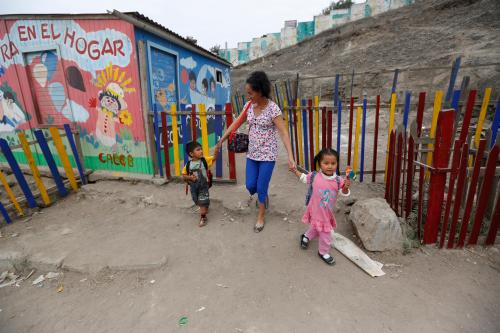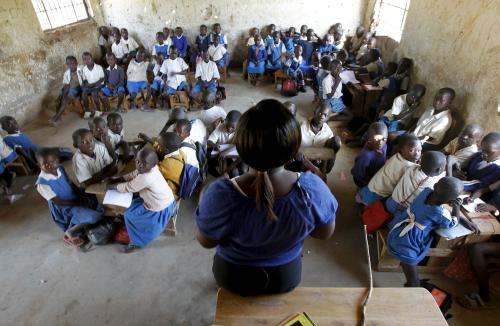In a recent article, Early Childhood Development, The Promise and the Path Forward, we lay out what we see as the current state of affairs for early childhood development (ECD) in the developing world, we identify the main constraints to successfully scaling up ECD and we propose an agenda of research and policy action that attempts to address those constraints head on. The first of the constraints is around financing. This problem is twofold. First, budgets allocated to early childhood development are often far below the levels needed for the quality programming necessary to ensure that children reach their greatest potential later in life. Second, a focus on inputs alone leads to sub-optimal levels of service quality, which results in children not receiving the proper health care, education and social protection needed for them to develop to their highest capacity.
In response to the failure of existing systems, increasing attention is being given to new ways of financing and delivering social services. Innovative financing, which encompasses a broad spectrum of non-traditional private, donor and domestic financing mechanisms, was the topic of a panel session in our recent symposium on scaling up and financing global education. It was clear from that session and from subsequent smaller discussions on the topic that the landscape of financing the social sector is rapidly changing. We can’t help but think that there may be promising potential for harnessing this new landscape to benefit ECD.
Impact Investing
One of these innovative financing mechanisms, impact investing, is increasingly being used in the social sectors in both developed and developing countries. Impact investing pursues both financial and social or environmental returns (or so-called blended value), and has begun to attract such diverse groups as financial institutions, family endowments, foundations and pension funds to invest in addressing complex social challenges, including health, homelessness, affordable housing, education, agriculture and crime. Impact investing is complementary to existing investments as it provides an opportunity to leverage government and philanthropic contributions and thereby funnel in additional resources for social and environmental issues. Designed well, impact investing can also lead to increased accountability, efficiency gains, innovation and improved social outcomes.
Social Impact Bonds
One specific class of impact investing, the social impact bond (SIB), has gained particular attention in recent years. In this model, private investors put up capital to fund a social intervention and governments repay the investor only if an agreed-upon outcome is achieved. An independent evaluator then confirms whether the outcome is achieved through a rigorous impact evaluation. The key feature of a SIB is funding for prevention programs that have the potential to reduce more costly remediation later on. In addition, SIBs introduce an incentive for government agencies to work together to capture savings jointly. This model also benefits from the involvement of the philanthropic sector. For philanthropists, SIBs are an opportunity to achieve higher social yields than possible through direct donations, and they also allow the possibility of recycling funds for future investments. For private investors, the amount of risk is reduced, making investments more attractive. In the end, SIBs do much to align the desires of a diverse set of stakeholders, such as investors, governments, communities and nonprofit organizations. As a result, they can achieve both financial and social returns that in particular benefit the poor and vulnerable.
Currently, SIBs have been developed and are being explored in Australia, Canada, Colombia, India, Ireland, the United Kingdom and in several U.S. states. A development impact bond (DIB), is a variation of a SIB in which a donor agency, on its own or with a government, funds the repayment to the investor contingent on the achievement of the agreed outcome or savings. While no DIB has been implemented to date, two are in the works (India for low cost schooling for girls and Mozambique for malaria prevention) and several case studies are being examined for the purpose of exploring this mechanism.
A SIB for ECD in Utah
There are several proposals on the table for early childhood development SIBs in the United States, though to date there is only one example of a SIB for ECD that has been implemented. In 2013, a SIB was rolled out in Utah for preschool education for disadvantaged children aged 3 and 4. The SIB was designed to provide children access to a high-quality preschool program with a targeted curriculum to increase school readiness and academic performance. The expectation is that the preschool intervention will lead to fewer children needing special and remedial education once reaching kindergarten and through 12th grade, which will result in cost savings for the school districts, the state and other government entities. There are several parties involved in making this deal happen. Goldman Sachs is the lead investor is Goldman Sachs, and venture capitalist J.B. Pritzker has provided a subordinate loan to reduce the bank’s risk. In this deal, the Pritzker money will only be repaid after Goldman Sachs recoups their investment. United Way of Salt Lake oversees the daily implementation of the preschool provision and is also responsible for managing repayments to the private investors. This initiative is the first phase in a larger $20 million commitment by J.B. Pritzker, Goldman Sachs and other private investors for the Early Childhood Innovation Accelerator, a fund which aims to increase the availability of high-quality early childhood education while building a strong evidence-base of success.
Are SIBs the Answer for ECD in Developing Countries?
Preliminary observations give cause for optimism for the application of the SIB model to ECD in low or middle-income countries. Until now, the private sector has mainly contributed to ECD by providing services like preschool education (although mostly to higher income levels) and financial support or advocacy through corporate social responsibility (CSR) or philanthropic ventures. However, there are several reasons to believe that the private sector could play an important role in developing SIBs for ECD. First, the nature of ECD makes it a promising candidate. Unlike other services with entrenched interests, the multitude of agencies and non-state entities financing and providing ECD services potentially allows for more room for experimentation. Also, the preventive nature of ECD programs fits well with the core feature of SIBs, which is that preventive investments will result in improved outcomes and potentially cost savings later on. There is ample evidence that early childhood interventions have an impact on school readiness, learning and other outcomes. Costly remediation can be avoided if a focus on the early years means improved developmental outcomes at school entry. Second, SIBs have the potential to jointly address the two biggest problems faced in ECD—inadequate financing and poor quality of services. SIBs can bring in much-needed capital to finance interventions and simultaneously drive forward the issue of quality (since repayment of the investment is contingent upon the successful achievement of outcomes). We will need more experimentation on the ground to test these propositions. For our part, we are conducting a study that looks at the enabling conditions and potential pitfalls for SIBs for ECD in developing countries. The study will provide more answers on the prospects of this model to channel investments into delivery models that can operate at scale and produce good outcomes. Improved outcomes would in turn provide more convincing evidence for those who hold the keys to ensuring that all children reach their potential: parents of poor children and policymakers, who can, respectively, show greater interest and demand more quality from providers, and provide more political support and financing.
The Brookings Institution is committed to quality, independence, and impact.
We are supported by a diverse array of funders. In line with our values and policies, each Brookings publication represents the sole views of its author(s).








Commentary
Social Impact Bonds for Early Childhood Development: Making “Dollars and Sense” in Developing Countries
April 2, 2014